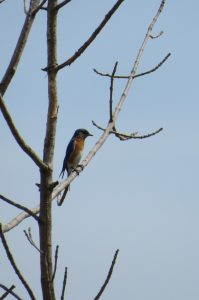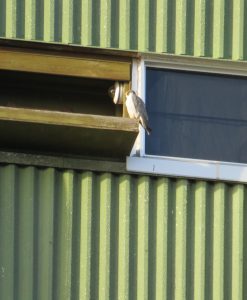
Eastern Bluebird (Sialia sialis)
Eastern Bluebirds are an easily recognizable species, appreciated by anyone with an enthusiasm for birds. Their bright blue and orange colours make them a colourful sight when seen perched over grasslands and forest edges. Bluebirds are cavity nesters, relying on openings in trees and other natural cavities or nest boxes. While initially an abundant species throughout Ontario, their population began to decline in the 1960s. Eastern Bluebirds faced habitat loss and competition for nesting sites with invasive species such as House Sparrows and European Starlings. When the public learned about this decline, many people took action to help conserve this species. Initiatives to set up bluebird boxes with special optimizations to keep out predators and invasive species allowed bluebirds to reproduce successfully once again and grow their population. By 1996, the Eastern Bluebird population had rebounded enough that they were taken off the COSEWIC list of endangered species, marking them as a conservation success story. Eastern Bluebirds are once again abundant throughout the province. However, their continued survival depends on conservation efforts, as they rely on bluebird boxes to reproduce at sufficient numbers. Eastern Bluebirds are an example of the impact that the public can have in conservation efforts, and are an encouraging success story. However, they still face hazards from invasive species, habitat loss, and climate change and continued conservation is crucial to their survival.
References:
Kraus, D. (2020, May 6). Tales of recovery: Eastern bluebird. NCC: Land Lines. https://www.natureconservancy.ca/en/blog/archive/tales-of-recovery-eastern.html

Peregrine Falcon (Falco peregrinus)
Peregrine Falcons are a charismatic raptor species, often considered the world’s fastest animal for its in-flight diving speed of over 300 km/h. They are skilled hunters, often taking down evasive prey species like pigeons and songbirds. Peregrine Falcons nest on tall cliffs or building ledges, preferably close to water. This species is widely distributed, and can be found on every continent except Antarctica. While historically present in Ontario, in the 1950s its population began to decline and it was extirpated from the province during the 1960s. This decline was largely caused by the pesticide DDT, which accumulated in falcons from their prey and weakened the eggshells, causing many to break before hatching. This species came close to extinction, but global conservation efforts allowed it to make a recovery and it can be found breeding in Ontario once again. Captive-breeding programs were an important part of the falcon recovery strategy in Ontario, and helped them make a comeback. These programs were phased out in 2006 as falcon populations became established. Peregrine Falcons are an important species to Hamilton, and became the city bird of Hamilton in 2022. Peregrine Falcons began nesting on the 18th floor of the Sheraton Hotel in downtown Hamilton in 1994. This sparked the creation of FalconWatch, a volunteer group dedicated to helping these falcons survive and thrive. This group began monitoring falcon nests on the Hotel and rescuing any chicks that got into danger as they began to learn to fly. Through these efforts FalconWatch has helped over 60 falcon chicks successfully spread their wings and fly. Their efforts also spread public awareness of these birds and the risks they face, making them a public icon in the city. While peregrine falcons still face threats from habitat loss and pollution, they are a conservation success story in Hamilton and beyond.
References:
Howells, L. (2019, April 24). 25 years of falcons: Hamilton Falconwatch celebrates milestone birthday. CBCnews. https://www.cbc.ca/news/canada/hamilton/25-years-of-falcons-hamilton-falconwatch-celebrates-milestone-birthday-1.5107371
Kiff, L. (2023, October 21). Peregrine falcon. Encyclopædia Britannica. https://www.britannica.com/animal/peregrine-falcon
Peregrine falcon. ontario.ca. (n.d.-b). https://www.ontario.ca/page/peregrine-falcon
Rosas, A. C. (2022, March 22). Hamiltonians pick the Peregrine Falcon, a creature with a long, local history, as City Bird. CBCnews. https://www.cbc.ca/news/canada/hamilton/unofficial-city-bird-1.6393960
